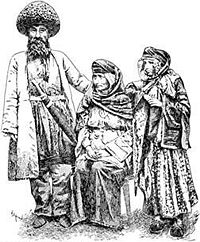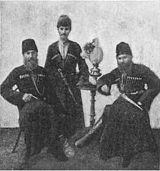- Mountain Jews
-
Mountain Jews
Juhuro
Total population 2004: 150,000 to 270,000 (estimated)
1959: 25,000 (estimated)
1926: 26,000 (estimated)Regions with significant populations Azerbaijan, Chechnya, Dagestan, Israel,
United States, Russia Israel
Israel100,000 to 140,000  United States
United States10,000 to 40,000  Russia
Russia20,000 to 40,000  Azerbaijan
Azerbaijan12,000 to 30,000 (according to Highland Jews community in Baku)  European Union
European Union3,000 to 10,000  Kazakhstan[citation needed]
Kazakhstan[citation needed]2,000 Languages Religion Related ethnic groups Highland Jews, Mountain Jews or Kavkazi Jews also known as Juvuro or Juhuro, are Jews of the eastern Caucasus, mainly of Azerbaijan and Dagestan. They are also known as Caucasus Jews, Caucasian Jews, or less commonly East Caucasian Jews, because the majority of these Jews settled the eastern part of the Caucasus. There were some historical settlements in Northwest Caucasus. Despite their name, the "Highland Jews" or "Mountain Jews" or "Caucasian Jews" do not include the Georgian Jews of the Caucasus Mountains.
In terms of ethnic origin, the Highland Jews and Tats are believed to have inhabited Caucasia for many centuries. Their distant forefathers once lived in southwest Persia, the southwestern part of present-day Iran. There they adopted the Middle Persian language. The predecessors of the Highland Jews settled in Caucasian Albania in the 5th–6th century; from then their history has been related to the mountains and the people of Dagestan.
"After fleeing persecution in Persia, they migrated north to mountain villages on both sides of the high peaks between the Black Sea and the Caspian. They still speak a dialect of Persian; few know more than the odd Hebrew phrase. For centuries Qırmızı Qəsəbə (also known as Krasnaya Sloboda in Russian) in Azerbaijan, perhaps the only completely Jewish settlement outside Israel, kept its traditions intact while surrounded by Muslims. In 1991 the fall of the Soviet Union and resulting unrest prompted a mass Jewish exodus. In recent years, the population has plummeted as inhabitants emigrate to Israel, America and Europe. It is the last stronghold of the Caucasus Mountain Jews, or Juhuri."[1]
"The number of Juhuri in the Caucasus regions outside Azerbaijan is also declining rapidly. In neighbouring Russia, thousands of Mountain Jews have emigrated from Dagestan because of their perception of threat from Islamic fundamentalism and other violence. In April 2003, vandals desecrated 42 Jewish graves in the region."[1]
Contents
Ethnic origins and history
In terms of ethnic origin, Jews have inhabited Caucasia for centuries. Their distant forefathers once lived in southwest Persia[1], the south-western part of present-day Iran. There they adopted the Middle Persian language. The predecessors of the Mountain Jews settled in Caucasian Albania in the 5th–6th century; since then their history has been related to the mountains and the people of Azerbaijan and Dagestan. Some historians[who?] believe they may be descended from Jewish military colonists, settled by Parthian and Sassanid rulers in the Caucasus as frontier guards against nomadic incursions from the Pontic steppe.
In the 18th–19th century, the Jews resettled from the highland to the coastal lowlands but carried the name "Highland Jews" or "Mountain Jews" with them. In the villages (aouls) the Highland/Mountain Jews settled in a part of their own; in towns they did the same, although their dwellings did not differ from those of their neighbours. The Highland Jews adopted the dress of the highlanders. Judaic prohibitions ensured they retained specific dishes, and they enshrined their faith in the rules for family life.
In Chechnya, the Jews became notably well-integrated into Chechen society. A clan, Dzugtoi, was formed for Chechen Jews long ago, perhaps during the Middle Ages. In Chechen culture, there is an assembly of clans (taips). Of the total 90, 20 were originally founded by foreigners (a new taip can be founded at any time as long as there is a considerable founding group).[2] In founding the new taip, its members pledged eternal loyalty to the Chechen nation, and hence became part of the nation, being simultaneously Chechens and Jews (there are also Polish, Russian, Armenian, Georgian, Turkish and other clans).[2][3] Over time they become more and more integrated, due both to assimilation and to the Chechen populace becoming used to their presence. Interclan marriages were common, so eventually the Chechen Jews became largely indistinguishable from other Chechen, except for their faith.[2][3] The original Highland Jews of Chechnya now speak mostly Chechen.[4]
Historians such as Andrey Zelev, Leonti Mroveli and Rusland Khasbulatov believe that the Jews also influenced Chechen culture.[5][6] Many common Chechen family names, usually attributed to Arabic origin due to their Semitic roots, have been shown to have existed before the Islamization of Chechnya. According to Zelev, many Chechen place names show Jewish influence. The historians Mroveli and Khasbulatov, who states that Chechen are 30% Jewish in ancestry, also support the idea of Jewish influence. Their theories are controversial, and have not achieved widespread acceptance.[7]
While elsewhere in the Jewish diaspora, Jews were prohibited from owning land (cf. the Jews of Central Asia), at the end of the 19th and the beginning of the 20th century, the Highland Jews owned land and were farmers and gardeners, growing mainly grain. Their oldest occupation was rice-growing, but they also raised silkworms and cultivated tobacco. The Jewish vineyards were especially notable. The Jews and their Christian Armenian neighbors were the main producers of wine, an activity prohibited for Muslims by their religion. Judaism, in turn, limited some types of meat consumption. Unlike their neighbors, the Jews raised few domestic animals. At the same time, they were renowned tanners. Tanning was their third most important economic activity after farming and gardening. At the end of the 19th century, 6% of Jews were engaged in this trade. Handicrafts and commerce were mostly practiced by Jews in towns.
The Soviet authorities bound the Highland Jews to collective farms, but allowed them to continue their traditional cultivation of grapes, tobacco, and vegetables; and making wine. The former isolated lifestyle of the Jews has practically ended, and they live side by side with other ethnic groups.
Originally, only boys were educated and they attended synagogue schools. With Sovietization, Tat became the language of instruction at newly-founded elementary schools. This policy continued until the beginning of World War II. In 1928, the first native-language newspaper, Zakhmetkesh (Working People), was published. After WWII, Russian was the required language at quba schools, and the newspaper stopped publication. Highland Jewish intellectuals are active in qubai culture.[citation needed]
Notable Highland Jews
- Yekutiel ("Kuti") Adam - a Major General in the Israel Defense Forces, the highest-ranking Israeli soldier to be killed in combat.
- Aluf Ehud "Udi" Adam - a General in the IDF and the former head of the Israeli Northern Command.[citation needed]
- Yehezqel Nissanov - one of the founder of the organizations Bar-Giora (1907) and Hashomer (1909) ניסנוב
- Albert Agarunov - a Starshina of the Azerbaijani Army who died during the Nagorno-Karabakh War.
- Abramov Shatiel Semenovich - Hero of the Soviet Union[8]
- Yefrem Amiramov - Russian poet and musician. (Амирамов, Ефрем Григорьевич).
- Ismakov, George Shahmanovich - Composer, poet, "Honored Artist of Dagestan."
- Astrix - Israeli Psychedelic Trance DJ (real name Avi Shmailov).[9]
- Jacob Avshalomov - composer and conductor.
- Sarit Hadad - a famous Israeli singer, born "Sara Hudadatov."
- Julieta (singer) - israeli pop singer.
- Omer Adam - Israeli singer specializing mainly in Oriental Middle Eastern and Mizrahi music.
- Maya Simantov - Dance-R&B singer.
- Jasmin (singer) - Russian pop singer.[list membership disputed]
- Ayan Babakishiyeva - Azerbaijan pop singer (real name Ayan Babakishiyeva, Айан Бабакишиева).
- Yaffa Yarkoni - Israeli singer, born as Yaffa Abramov, winner of the "Israel Prize" in 1998.
- Gavril Ilizarov - a prominent Soviet physician, orthopedic surgeon, and inventor of the Ilizarov apparatus.[citation needed]
- Lior Rafaelov - Israeli football player.
- Zarah Iliev - Russian billionaire[10]
- Telman Ismailov - Moscow billionaire, owner of AST group.
- Mirza Khazar (Mirzə Xəzər) - Azerbaijani journalist, author, and anchorman of Radio Liberty (Azadliq)[11]
- God Nisanov - Russian billionaire, general director of Biskvit.[12]
- Yan Abramov - Russian multi-millionaire, husband to pop artist Alsou.[13]
- Matvey Elizarov - Azerbaijani businessman and philanthropist, a Vice-President of the World Congress of Mountain Jews.
- Zaur Gilalov - Moscow multi-millionaire from Azerbaijan; was the head of the World Congress of Mountain Jews and a successful businessman; founder of the Zar Group.
References
- ^ a b c Tom Parfitt, "Life drains away from lost tribe of Mountain Jews", The Telegraph, 27 April 2003, accessed 8 Dec 2010
- ^ a b c latautonomy.org
- ^ a b shamsali.org
- ^ chechnyafree.ru
- ^ proza.ru (Russian)
- ^ English version, though less extensive
- ^ proza.ru
- ^ Translation
- ^ djmag.com, Top 100 DJs, 2007 ranking]
- ^ "Zarakh Iliev", Forbes
- ^ mirzexezerinsesi.net
- ^ [1]
- ^ russiablog.org
- Some text used with permission from eki.ee, Original text
External links
- query.nytimes.com, New York Times
- juhuro.com, website created by Vadim Alhasov in 2001. Daily updates reflect the life of Mountain Jewish (juhuro) community around the globe.
- newfront.us, New Frontier is a monthly Highland Jewish newspaper, founded in 2003. International circulation via its web site. «Новый Рубеж» является ежемесячной газетой Горско-Еврейской общины США. Она издается с мая месяца 2003 года. Отражая жизнь общины не только в пределах своей страны, она информирует о новостях и событиях происходящих в Горско-Еврейских общинах во всем мире.
- keshev-k.com, Israeli website of Highland Jews.
- gorskie.ru, Highland Jews, website in Russian language.
- "Judæo-Tat", Ethnologue
- YouTube video Aji tu yorma, aji
History of the Jews in Europe Sovereign
states- Albania
- Andorra
- Armenia
- Austria
- Azerbaijan
- Belarus
- Belgium
- Bosnia and Herzegovina
- Bulgaria
- Croatia
- Cyprus
- Czech Republic
- Denmark
- Estonia
- Finland
- France
- Georgia
- Germany
- Greece
- Hungary
- Iceland
- Ireland
- Italy
- Kazakhstan
- Latvia
- Liechtenstein
- Lithuania
- Luxembourg
- Macedonia
- Malta
- Moldova
- Monaco
- Montenegro
- Netherlands
- Norway
- Poland
- Portugal
- Romania
- Russia
- San Marino
- Serbia
- Slovakia
- Slovenia
- Spain
- Sweden
- Switzerland
- Turkey
- Ukraine
- United Kingdom
- (England
- Northern Ireland
- Scotland
- Wales)
States with limited
recognition- Abkhazia
- Kosovo
- Nagorno-Karabakh
- Northern Cyprus
- South Ossetia
- Transnistria
Dependencies
and other territories- Åland
- Faroe Islands
- Gibraltar
- Guernsey
- Jan Mayen
- Jersey
- Isle of Man
- Svalbard
Other entities Categories:- Azerbaijani Jews
- Ethnic groups in Dagestan
- Iranian peoples
- Jewish ethnic groups
- Jews and Judaism in Kazakhstan
- Jews and Judaism in Persia and Iran
- Peoples of the Caucasus
- Caucasus Jews
Wikimedia Foundation. 2010.


